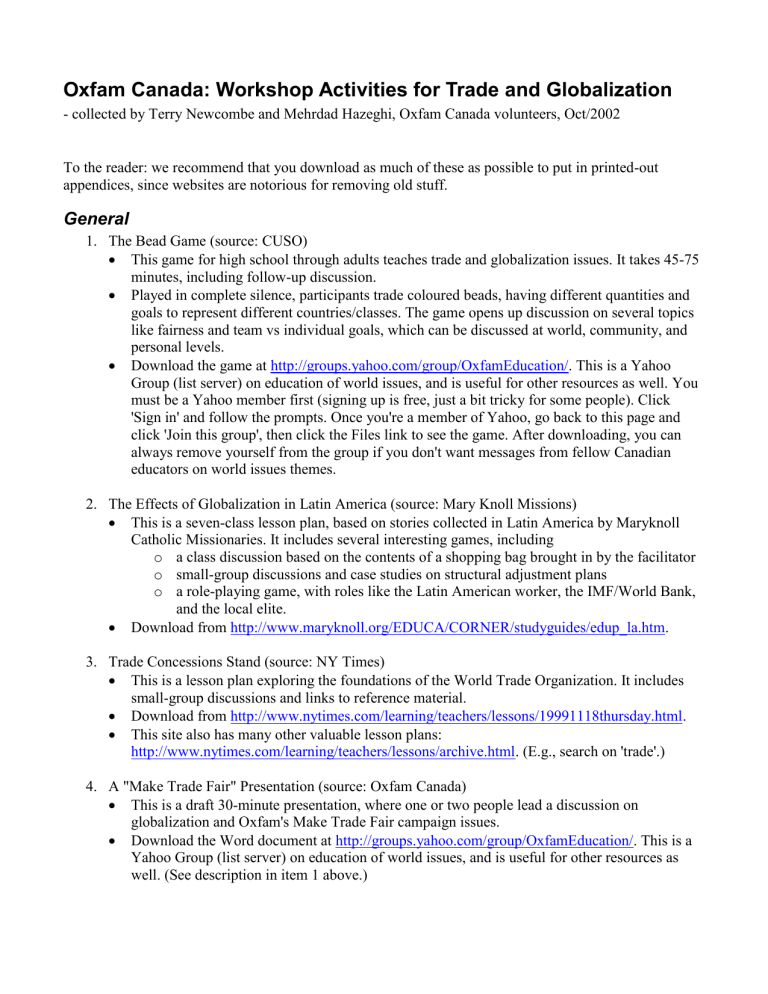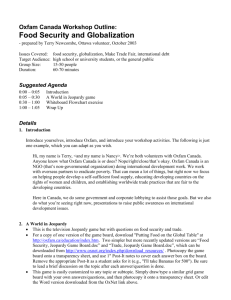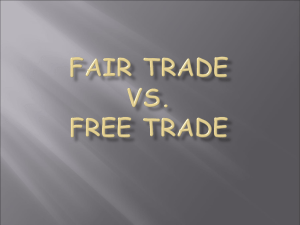
Oxfam Canada: Workshop Activities for Trade and Globalization
- collected by Terry Newcombe and Mehrdad Hazeghi, Oxfam Canada volunteers, Oct/2002
To the reader: we recommend that you download as much of these as possible to put in printed-out
appendices, since websites are notorious for removing old stuff.
General
1. The Bead Game (source: CUSO)
This game for high school through adults teaches trade and globalization issues. It takes 45-75
minutes, including follow-up discussion.
Played in complete silence, participants trade coloured beads, having different quantities and
goals to represent different countries/classes. The game opens up discussion on several topics
like fairness and team vs individual goals, which can be discussed at world, community, and
personal levels.
Download the game at http://groups.yahoo.com/group/OxfamEducation/. This is a Yahoo
Group (list server) on education of world issues, and is useful for other resources as well. You
must be a Yahoo member first (signing up is free, just a bit tricky for some people). Click
'Sign in' and follow the prompts. Once you're a member of Yahoo, go back to this page and
click 'Join this group', then click the Files link to see the game. After downloading, you can
always remove yourself from the group if you don't want messages from fellow Canadian
educators on world issues themes.
2. The Effects of Globalization in Latin America (source: Mary Knoll Missions)
This is a seven-class lesson plan, based on stories collected in Latin America by Maryknoll
Catholic Missionaries. It includes several interesting games, including
o a class discussion based on the contents of a shopping bag brought in by the facilitator
o small-group discussions and case studies on structural adjustment plans
o a role-playing game, with roles like the Latin American worker, the IMF/World Bank,
and the local elite.
Download from http://www.maryknoll.org/EDUCA/CORNER/studyguides/edup_la.htm.
3. Trade Concessions Stand (source: NY Times)
This is a lesson plan exploring the foundations of the World Trade Organization. It includes
small-group discussions and links to reference material.
Download from http://www.nytimes.com/learning/teachers/lessons/19991118thursday.html.
This site also has many other valuable lesson plans:
http://www.nytimes.com/learning/teachers/lessons/archive.html. (E.g., search on 'trade'.)
4. A "Make Trade Fair" Presentation (source: Oxfam Canada)
This is a draft 30-minute presentation, where one or two people lead a discussion on
globalization and Oxfam's Make Trade Fair campaign issues.
Download the Word document at http://groups.yahoo.com/group/OxfamEducation/. This is a
Yahoo Group (list server) on education of world issues, and is useful for other resources as
well. (See description in item 1 above.)
Sweatshops
1. A Sweatshop Fashion Show (source: Maquila Solidarity Network)
This is an easy, fun and creative educational tool to inform ourselves and people in our
communities about the sweatshop abuses hidden behind the labels of the major brands.
Download a sample script and instructions at
http://www.maquilasolidarity.org/tools/campaign/fashionshow.htm.
This takes as few as two facilitators if you use the workshop participants as models, otherwise
it needs 2-5 additional facilitators.
2. Sweatshop Christmas Carols (in season)
As a short activity/filler, get the class to sing a Christmas Carol or two about sweatshops, and
then ask them what the issues are in the song.
Download some sweatshop carols at
http://www.maquilasolidarity.org/tools/campaign/carols.htm, or make your own by modifying
popular carols with current trade/sweatshop issues.
3. Sweating the Big Stuff (source: NY Times)
This is a lesson plan on labour conditions around the world. It includes small-group
discussions and links to reference material.
Download from http://www.nytimes.com/learning/teachers/lessons/20010425wednesday.html.
This site also has other valuable lesson plans:
http://www.nytimes.com/learning/teachers/lessons/archive.html
4. Just Fashion: Small-group Discussions (source: One World Research and Education Network,
OWREN)
This website provides five participative activities to learn about sweatshop and child labour
issues. One is a check-each-other's-clothing-tags game, one is a questionnaire promoting
discussion, and three are small-group discussions.
This site also includes many related reading/speaking resources, as well as a section on things
to reflect on after taking part in the activities.
View or download the activities at http://www.owren.org/jf/index.html.
This organization also has similar activities on themes of Poverty and Human Rights, at
http://www.owren.org.
5. The Transnational Capital Auction (source: Bill Bigelow)
The first half of this page is "The Human Lives Behind the Labels" (sweatshops), but scroll
down to "The Transnational Capital Auction"), a game whereby the students represent several
countries competing for business from a transnational like Nike. This quickly turns into a 'race
to the bottom'.
Download from http://www.rethinkingschools.org/Archives/11_04/swetm.htm.
This page has other games, mostly on sweatshop themes.
Food Security and Trade
1. A World in Jeopardy (source: Oxfam Canada)
This is the television Jeopardy game but with questions on food security and trade.
For a copy of one version of the game board, download "Putting Food on the Global Table" at
http://oxfam.ca/education/index.htm.
Photocopy the game board onto a transparency sheet, and use 1" Post-It notes to cover each
answer box on the board. Remove the appropriate Post-It as a student asks for it (e.g., "I'll take
Bananas for 500"). Be sure to lead a brief discussion on the topic after each answer/question is
done.
This game is easily customized to any topic or subtopic. Simply draw/type a similar grid game
board with your own answers/questions, and then photocopy it onto a transparency sheet.
2. A Supermarket Field Trip (source: Oxfam Canada)
Break the class up into groups of no more than six, and each team goes to a different section of
a supermarket or produce market with one facilitator per group.
Walk through the aisles, picking out pre-determined items and talking about them in a trade
context. E.g., GMO foods for issues like labeling and exports, coffee/tea/hot chocolate/bananas
for fair trade, fruit/vegetables for issues like 'eating local vs. international' and 'monoculture
growing' and 'raw vs. processed importing tariffs' and 'pesticide/fertilizer use'.
Make it participative by asking your group what the issues are with a particular food before
informing them. Encourage discussion, and even ask if they have any sections of the
supermarket that they think the group should go to.
This activity must be cleared with the supermarket owner first! Stress that you're not
protestors, that there'll be no leafleting, that it's school-approved, and that there'll only be five
(or whatever) groups of seven people per group, all in separate areas of the store, and only for
45 minutes.
Of course, this activity works best if the site/school is a short walk from the supermarket.
3. Whiteboard Flowcharting
This exercise has one or two facilitators drawing a flowchart on the whiteboard, based on
student answers to questions posed by the facilitators. The goal is to end up with a visual
diagram of the interactions between various issues. The chart's contents can vary with the
specific topic discussed, but we will give an example of how food security relates to
globalization.
What You Say
What You Draw
a. Explain that up until fifty years ago, farmers around Monoculture
the world tended to grow the crops they wanted to
eat, and enough extra to sell for the things they
yields up
needed. Then science and farming mixed to create
this thing called the Green Revolution [Q. What
was this?], where it was shown that you can
produce huge yields by just focusing on a single
crop (e.g., corn, coffee, rice, sugar, bananas) and
using lots of chemical fertilizer and irrigation.
b. This indeed brought yields up (more food
produced). Poor countries rushed into monoculture yields up more export, more $
growing, resulting in [Q. in what?] more food to
sell and export, and thus more income to the
farmers and poor countries. Monoculture is thus
also known as cash crops.
c. But this had some bad side effects on the farmland.
[Q. What side effects?][Modify the flowchart
monoculture weakened soil
sequence based on answers.] One was that
monoculture drains the soil of nutrients. Rotating to
different crops each year was a common practice to
keep the soil healthy.
d. Over the years, this brought the yield down. It also
decreased the soil's resistance to weeds.
e. [Q. So what did farmers do to bring the yields back
up?] They used more chemical fertilizer, pesticides,
and herbicides.
f. But this also brought some bad news. [Q. What bad
news?]
g. Farmers are also encouraged to use more big farm
machinery to get better yields. [Q. What effects
does this have?]
h. After farmers around the world had become caught
in this cycle, the producers of fertilizers, pesticides,
and herbicides raised their prices. [Q. What effects
would this have?]
i. Around the same time this was happening, so many
poor countries had been encouraged to grow cash
crops for export to the first world countries that
there was now a surplus on the world market. [Q.
What does this cause?] This causes prices to drop.
(Side point: note that it is the poor countries
growing the raw materials at low profits, and the
monoculture weakened soil
yields down more pests &
weeds yields further down
(circle)
yields up
more fertilizers, pesticides, and
herbicides costs more money
less profit
fertilizers are short & harsh
nutrients soil gets weaker,
and can only grow thereafter
with increasingly stronger
amounts of fertilizer more
money (circle)
pesticides are indiscriminant,
killing insects and (through the
food chain) birds that are
otherwise helpful to the land
and the crops soil gets
weaker (circle)
buy expensive farm equipment
less profits
farmers in poor countries
become tied into foreigncontrolled technologies &
businesses loss of self
control over farming industry
higher prices for fertilizer,
pesticides, herbicides
farmers had even less profit
some farmers couldn't afford
enough fert/pest/herbicides
yields stayed low
world surpluses prices drop
profits less (circle)
j.
k.
l.
m.
n.
o.
rich countries producing the processed products
like chemical fertilizers at high profits.
[Q. How does this all affect the financial balance
between the first world/industrial countries and the
third world/developing countries?] The already
developed countries get stronger economically
(paying less for food and making more profit on
exported fertilizers, pesticides, and herbicides),
while the developing countries get weaker
economically.
[Q. What happens when the farmers can't sell
enough crops to pay their fert/pest/insecticide
costs?] This quickly gets to the point where farmers
can't afford to farm. [Q. So what can they do?]
They have to sell their farms (or often lose them
completely to debts), usually to large farming
businesses with ties to first world farming
industries ('agrobusinesses') more control of the
poor countries' economies gets transferred to the
first world businesses
[Q. How does this all affect the financial balance
between the first world/industrial countries and the
third world/developing countries?] This results in
more control of the poor countries' economies
being transferred to the first world businesses.
[Q. So what happens to the farmers after selling
their farms?] Often the farmers become hired
workers of the agrobusinesses. [Q. Why is this
bad?] Now they get very low pay (due to the
surplus of available workers and the increased use
of machinery) and they don't have their own crops
anymore to feed their families.
Farmers and their families often have no choice but
to leave the countryside completely and move to
the cities, looking for employment and food. Often
they can't find either due to overcrowded cities. [Q.
What does this lead to?] This leads to
unemployment, slums, poor health, and violence.
All are drains on the social and economic systems
of the country.
The country is now trying to keep up its exports
while having higher social and economic costs. It is
increasingly having its choices directed by the big
agrobusinesses that own more and more of the
farmland. [Q. Why is this such a bad thing?] These
businesses are often foreign controlled. The poor
countries end up making economic decisions based
on what is best for the transnational agrobusinesses
and not their own economy. Once again, the first
rich richer, poor poorer (circle)
can't afford to farm
sell or lose farms to
agrobusinesses
first world controls more
(circle)
hired workers lower pay, no
food to eat
move to cities
unemployment slums
poor health and violence
drains on social and economic
systems
country's choices directed by
agrobusinesses' needs
making decisions to improve
the agrobusinesses, not the
country
first world controls more
(circle)
world's control over the poor countries increases.
The poor countries become low class workers
forced to stay at that level so that the first world
countries can keep their low food imports and high
processed-material exports. (Optionally, at this
point, you can get into how first world countries set
high tariffs on processed foods and goods, to keep
their dominance on these higher-profit markets.}
p. (Optionally, you can also bring up another path
when farmers lose their land. They cut down
rainforest, usually illegally, and plant crops. But
rainforest soil is a delicate balance formed over
thousands of years. Just 10-20 years of cattle
grazing, for example, can completely destroy that
land which once held hundreds of tree varieties, so
that it now only holds two or three types of low
brush.) (This can lead to an environmental
flowchart if desired.)
At this point, you can move to another whiteboard and say that this all sounds pretty gloomy.
What can be done to get the poor countries out of this dead end? Bring up solutions like
(a) The first world (WTO, World Bank, IMF) can better control world industries to avoid giant
surpluses.
(b) The first world can drop tariffs (import taxes) on processed foods, allowing poor countries
to develop food industries beyond simple farming (diversity and higher profits).
(c) Farmers can return to the model of many small family-owned farms producing multiple
foods, and rotating crops. This reduces need for chemical fertilizers, pesticides, and herbicides,
while also ensuring that farmers not growing enough to sell will at least have some food to eat.
Many first-world non-governmental agencies are involved in training farmers in sustainable
agricultural practices.
(d) First world agrobusinesses must recognize that the big picture requires thinking beyond
increasing their profits at all costs. It requires thinking beyond "we have to answer to our
stockholders". And the stockholders in turn have to realize the same. Many multinational
businesses are now making decisions to improve farmers' situations based on pressure put on
them by some of their own socially responsible stockholders. You and your parents can
support such socially responsible investing (SRIs).
(e) Organize a group of students to have your school adopt a no-sweatshops buying policy.
Pressure on manufacturers of clothing and sports equipment to provide healthy environments
and fair wages to workers will help strengthen the countries providing those products, giving
them alternative economies to cash crops.
(f) Organize a group of students to commit your school cafeteria, and/or nearby coffee shops,
to sell at least one regular fair-trade brand of coffee, tea, and hot chocolate.
(g) Don't underestimate the power of writing letters, both individually and by starting up
campaigns to do so. Target the PM, your own MPs, the ministers responsible for the areas
you'd like change in, and corporations themselves.
When discussing what YOU can do specifically, discuss the common feeling of "It's hopeless,
we're just a few against the powerful." Give Margaret Mead's quote:" Never doubt that a small
group of thoughtful, committed citizens can change the world. Indeed, it's the only thing that
ever has." And then discuss who you're up against: governments and corporations. The
governments are supposed to be driven by the people, but the unofficial rule is that the loudest
people count the most – ask who that group is. Answer: corporations, since they pay millions
to lobby governments heavily. They also donate to governments heavily, both officially and
under the table. Whose policy would you support if you were the government? The one a
bunch of individual voters ask for, or the one asked for by the people who keep your party
financially afloat and in power? Conclusion: Canadians don't have as 'true' a democracy as we
like to think. We allow corporations to control the government by allowing such lobbying and
donations. Solution: get those letters going to put a cap on (or stop completely) corporate
donations to political parties. And we can't stop lobbying, as a valued part of our democracy,
but we can have caps put on it so that the rich corporations don't overcome the voices of the
people.
Final conclusion: end on a high note of taking positive action individually and together.
If you have feedback or additional activities, please contact Terry Newcombe (terrynew@sympatico.ca).



